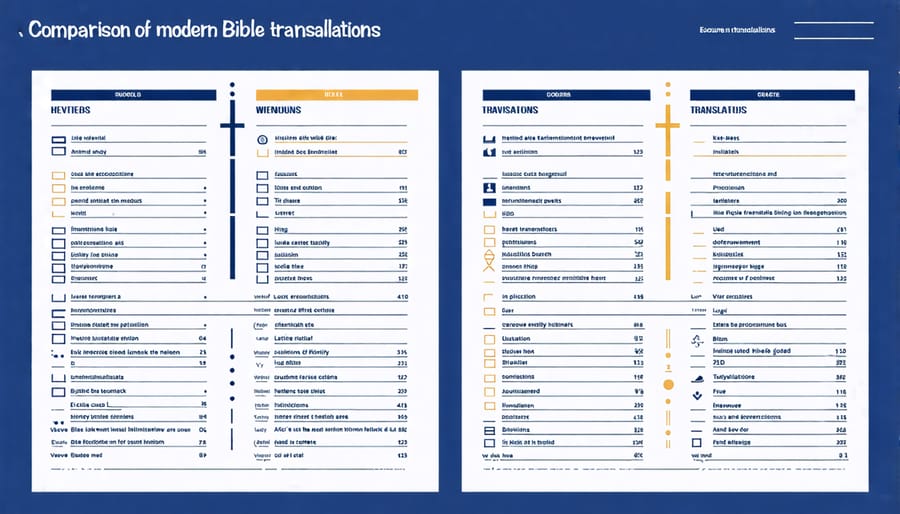Explore the evolution of Bible translation by diving into its profound impact on faith and spirituality across generations. Appreciate the faithful contributions of translators who have labored to make the Bible accessible in diverse languages, enriching personal and communal faith experiences worldwide. Reflect on the significance of words and their meanings in different translations, uncovering deeper insights into biblical truths and principles tailored to your spiritual journey. Engage with your community to discuss how various translations resonate with faith practices today, fostering understanding and unity within diverse Christian traditions.
The Historical Context of Bible Translation
Early Translations and Their Impact
The earliest translations of the Bible played a significant role in shaping religious practice and spreading the Christian faith. The Greek Septuagint, dating back to the 3rd century BCE, was one of the first major translations, making the Hebrew scriptures accessible to Greek-speaking communities. This translation was crucial in areas where Greek culture was predominant, providing a shared spiritual text that unified diverse believers.
Later, the Latin Vulgate, translated by St. Jerome in the late 4th century, became the standard Bible for Western Christianity for centuries. It emphasized the importance of scripture being available in a language understood by the clergy and connected diverse groups within the Christian community.
These translations not only facilitated the dissemination of the faith but also encouraged a more personal and communal engagement with the Bible. They allowed believers to encounter God’s word in their own context, fostering spiritual growth and understanding. Early translations highlight the enduring impact of ensuring the Bible speaks directly to the hearts of its readers, inspiring a deeper connection with God’s teachings.

The Role of Key Figures in Translation
Throughout history, key figures have played significant roles in the translation of the Bible, ensuring that its transformative messages reach diverse audiences worldwide. Among these devoted individuals was St. Jerome, who, in the late 4th century, translated the Bible into Latin, known as the Vulgate. His work laid critical foundations for later translations and allowed the scripture to touch countless lives across generations. Fast forward to the 16th century, Martin Luther rose as a pivotal figure, translating the Bible into German. This opened up access to the Word for ordinary people, catalyzing the Protestant Reformation and encouraging personal faith encounters.
In the English-speaking world, William Tyndale’s contributions cannot be overstated. Despite considerable opposition, Tyndale translated the New Testament into English, driven by a desire to make the scriptures available to all. His translation became a cornerstone for future English versions. Later, the 1611 King James Version brought together the efforts of numerous scholars, resulting in a translation renowned for its literary beauty and spiritual depth.
Each of these figures approached translation with a deep faith and a desire to share the gospel, reminding us of the power and importance of making God’s Word inclusive and accessible. Their stories encourage believers today to cherish and study the scriptures, allowing its truths to guide their spiritual journey.

Understanding the Nuances of Translation
Linguistic Challenges
Translating the Bible is a complex process that involves overcoming significant linguistic challenges. The original texts of the Bible were written in ancient languages like Hebrew, Aramaic, and Greek, each with unique structures, idioms, and cultural contexts. These languages have evolved drastically over the centuries, presenting a challenge for translators aiming to convey the original message accurately to today’s readers. Words and phrases often carry nuanced meanings that are not directly translatable, requiring thoughtful interpretation to prevent biblical misinterpretations. Additionally, metaphors and parables that resonated with ancient audiences may not translate easily into the modern mindset, necessitating careful attention to preserve their spiritual essence. Translators work tirelessly to maintain the integrity of the Scriptures, striving to provide editions that inspire faith, understanding, and communion in diverse cultural settings, while acknowledging the deep-rooted spiritual truths that remain relevant across time and tradition. By fostering an appreciation for these linguistic nuances, believers can deepen their relationship with Christ and the communal faith experience.
Cultural and Contextual Adaptations
Translation of the Bible involves more than just word-for-word substitution from one language to another. It’s a thoughtful process that strives to convey the cultural and contextual nuances embedded in the original texts. Translators engage deeply with the historical context in which the Scriptures were written, seeking to preserve the intent and meaning behind the words. For example, understanding the agrarian culture of ancient Israel enriches our comprehension of parables about seeds and harvests, allowing us to grasp their spiritual implications in today’s world.
The challenge lies in bridging the gap between ancient customs and contemporary understanding, which translators approach with prayerful intention. Each translation effort offers fresh insights into biblical teachings, helping believers apply timeless truths to their own lives. By making these ancient writings accessible and meaningful, translation serves as a bridge, drawing us closer to God’s message and enabling us to live out His love within our diverse communities. As we immerse ourselves in the richness of Scripture, we grow spiritually and deepen our relationship with the Creator, uniting our hearts in faith and practice.
Modern Translations and Their Impact
Comparative Analysis of Modern Translations
When exploring the landscape of modern Bible translations, we encounter a beautifully diverse Bible translations world, each offering its own unique insights. The New International Version (NIV), for instance, is renowned for its balance between accessibility and accuracy, making it a favorite among many Christians who seek clarity and understanding. Meanwhile, the English Standard Version (ESV) offers a more word-for-word approach, which appeals to those who appreciate a closer representation of the original texts. For readers who desire a deeper, more contemporary connection to scripture, the New Living Translation (NLT) provides a thought-for-thought rendition that captures the heart of the message in everyday language. The Message Bible offers yet another perspective, seeking to invigorate familiar verses with cultural relevance and vibrant prose, encouraging personal reflection and community dialogue. By embracing these different translations, believers can enrich their spiritual journey and experience the divine Word through various lenses, each bringing them closer to a deeper understanding of faith.

Impact on Modern Worship and Study
Modern Bible translations play a significant role in contemporary worship and study by making scripture accessible and understandable to diverse congregations. For many believers, these translations are pivotal in creating a personal connection with the Word of God, facilitating a deeper spiritual journey. In worship settings, modern versions of the Bible enhance communal experiences by using language that resonates with everyday expressions, fostering a shared understanding during sermons and discussions.
In personal and group Bible study, these translations encourage engagement by illuminating biblical stories and principles in ways that speak to current realities. Verses like Jeremiah 29:11 remind us of God’s plans for hope and a future, making God’s promises relatable across ages and circumstances. By bridging cultural and linguistic gaps, modern translations unite believers in their quest for spiritual growth, promoting an inclusive environment where all voices are valued. Ultimately, this evolved understanding invites Christians to live out their faith through actions that reflect biblical teachings, nurturing community bonds and inspiring acts of service and love.
The Spiritual Significance of Translation
Personal Faith Journeys
For many Christians, their personal faith journey is intertwined with their engagement with the Word of God. The variety of Bible translations available today plays a significant role in this spiritual exploration. Each translation offers a unique lens, highlighting different nuances and perspectives that can enrich our understanding of biblical texts. This diversity allows individuals to find a version that resonates with their language and comprehension style, fostering a deeper, more personal connection with scripture. For those exploring faith independently or in community, utilizing diverse Bible study resources is crucial. They not only provide different translations but also context and insight, empowering believers to approach scripture with fresh eyes and an open heart, ultimately enriching their personal journey with God.
Broader Community and Church Impact
Translation of the Bible plays a vital role in uniting diverse communities under a shared faith, fostering understanding and unity among believers from varied backgrounds. By making the scriptures accessible in multiple languages, translation allows individuals to experience the teachings of Jesus in their native tongue, creating a more personal and meaningful connection to their faith. This inclusivity strengthens the communal bond, as believers gather to explore and discuss the word of God, transcending cultural and linguistic barriers. Such shared experiences encourage a deeper appreciation for the varied traditions within Christianity, leading to enriched fellowship and mutual respect. Ultimately, translation serves as a bridge, allowing everyone to partake in the communal journey of faith, encouraging spiritual growth and nurturing a collective Christian identity.
Conclusion
Reflecting on the transformative journey of Bible translation, we are reminded of its profound significance in connecting us to God’s Word across languages and cultures. From the earliest manuscripts to modern translations, this vital work has made the Scriptures accessible to millions, nurturing faith and understanding among diverse communities. Today, as we navigate an ever-changing world, the Bible’s timeless truths continue to offer guidance, comfort, and inspiration for all who seek a closer relationship with God.
The ongoing effort to translate the Bible underscores the importance of making the Word of God available to every heart. It is a testament to the dedication and expertise of those who labor in this field, ensuring that barriers of language do not hinder our ability to hear God’s voice. As Paul reminds us in Romans 10:17, “Consequently, faith comes from hearing the message, and the message is heard through the word about Christ.” These translations empower individuals to experience the Bible’s teachings personally and profoundly.
In embracing the various translations available to us, we are invited into a richer and more inclusive understanding of our shared faith heritage. Let us cherish the gift of Bible translation as a means of deepening our spiritual journey and fostering unity among believers of every nation and tongue.
